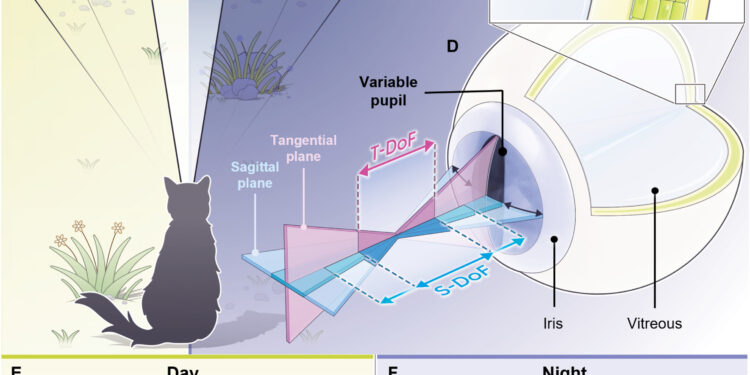Structural and functional features of feline eyes. (A and B) Schematic illustration showing the camouflage ability of a feline under various lighting conditions. (C) Enlarged schematic illustration of the tapetum lucidum of the retina. (D) Schematic illustration of the anatomy of the feline eye. (E and F) Schematic illustrations showing the visual ecology of feline and conventional vision during the day (E) and at night (F). Credit: Scientific progress (2024). DOI: 10.1126/sciadv.adp2809
A team of engineers from Seoul National University’s Nanoparticle Research Center, Gwangju Institute of Science and Technology, and Korea Institute of Science and Technology, all in Korea, have developed a new type of artificial eye based on natural cat eyes.
In their study published in the journal Scientific progressThe group copied two features of cat eyes that give them unique abilities to see in the dark and detect camouflaged objects.
As the researchers point out, the cameras installed on drones and robots are based on circular apertures that mimic the human eye, an approach that allows for images with a foreground subject and background kept in focus. This approach sometimes makes it difficult for the camera to track the target object.
Animals, like cats, use a different approach: they have vertically slit eyes to capture an asymmetrical depth of field. That’s why the researchers chose to use the architecture of the cat’s eye as a way to develop a new type of artificial eye.
Using animal eyes as a model to design new types of artificial eyes is, of course, nothing new. Last year, another team of researchers in Korea took inspiration from the cuttlefish eye to design a robot eye that could see better in dark and underwater conditions.
Imaging demonstration of the vision system inspired by the feline eye. Credit: Scientific progress (2024). DOI: 10.1126/sciadv.adp2809
For this new approach, the research team designed a vertical aperture, allowing the camera to keep a target sharp while the field behind it remains blurry, enabling better tracking of target objects during the day.
Cats see well at night thanks to a tapetum lucidum, a reflective layer behind the retina that improves sensitivity to light. It is also why cats’ eyes appear to glow at night. The researchers gave their artificial eye the same capabilities by adding silver metal reflectors behind the image sensor.
Together, these two features give the new camera the ability to see better in the dark and track target objects, even if they are hidden by camouflage.
More information:
Min Su Kim et al, Artificial vision inspired by the feline eye for improved camouflage capability in various lighting conditions, Scientific progress (2024). DOI: 10.1126/sciadv.adp2809
© 2024 Science X Network
Quote:Scientists mimic cat’s eyes to create artificial eye that sees better in the dark and detects camouflaged objects (2024, September 19) retrieved September 19, 2024 from
This document is subject to copyright. Apart from any fair dealing for the purpose of private study or research, no part may be reproduced without written permission. The content is provided for informational purposes only.



